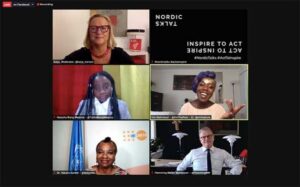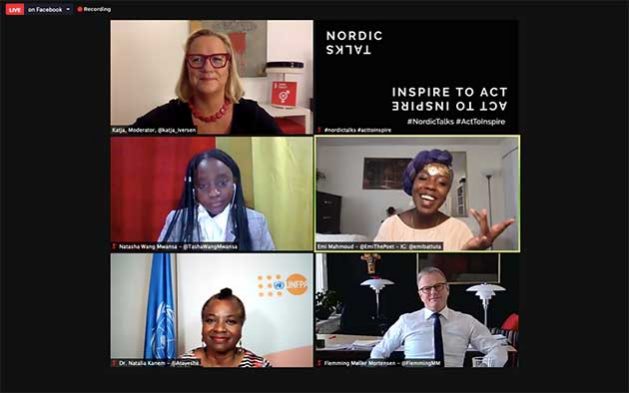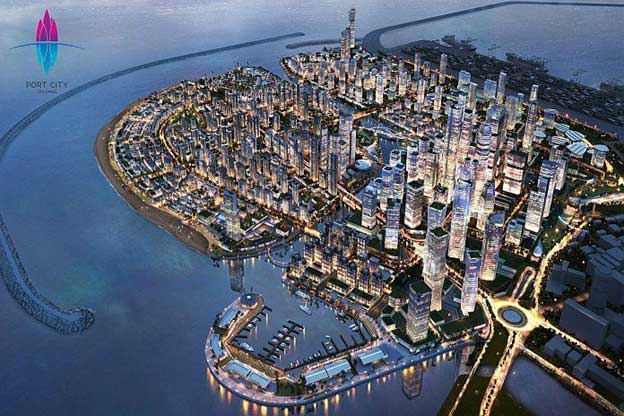
Civil Society, Crime & Justice, Development & Aid, Economy & Trade, Gender, Gender Violence, Global, Headlines, Health, Human Rights, Humanitarian Emergencies, Poverty & SDGs, TerraViva United Nations, Women’s Health

Nordic Talk moderator Katja Iversen shown here with Natasha Wang Mwansa, Emi Mahmoud, Dr Natalia Kanem and Flemming Møller Mortensen during a recent Nordic Talks webinar. Credit: Shuprova Tasneem
– Every two minutes, a girl or woman dies from pregnancy or childbirth-related complications, including unsafe abortions. Every year, around 12 million girls are married while in their childhoods. An additional 10 million are now at risk of child marriage due to the Covid-19 pandemic.
In this context, the most recent Nordic Talk—a high-level debate on bodily autonomy and sexual and reproductive health and rights (SRHR) as a cornerstone of gender equality, aptly titled “Let’s Talk About Sex” — could not have come at a better time.
Moderator Katja Iversen, Dane of the Year (2018) and former CEO of Women Deliver, kicked off the discussion by focusing on the close link between bodily autonomy, gender equality, economic growth, and a healthy planet.
In an exclusive interview with IPS, Iversen said it was clear that “bodily autonomy for girls and women—in all their rich diversity—is political, social, economic and health-related.”
Women needed to have power and agency over their “bodies, fertility, and future, living a life free of violence and coercion in both the private and public sphere. It ties into norms, structure, systems – and if we want equity and health for all, we need to address all of it.”
Emi Mahmoud, two-time World Champion Poet and Goodwill Ambassador for the UNHCR, set the tone for the Nordic Talk with her emotive poetry reflecting women’s experiences in patriarchal societies, asking: “What survivor hasn’t had her struggle made spectacle?”
The three other panellists agreed that the right to control their bodies was a fundamental aspect of women’s rights and that gender equality was an essential part of the sustainable development agenda.
As Dr Natalia Kanem, Executive Director of the UNFPA, explained that “(women’s) freedom over her own body means freedom of choice”, and that all the data points towards how investment in SRHR could be the first step to empowering women to “ultimately contribute to sustainable development.”
It was critical that SRHR was adequately resourced – but warned these would be in short supply because of the COVID pandemic recovery plans.
“Part of the financing challenge is what we abbreviate as political will. It actually does not cost a lot for the agenda for SRHR to be a reality by 2030. It would take $26 billion a year to end the unmet need for contraception and to stop mothers dying at birth, many of whom were too young to be pregnant, but resources are going to be a challenge now with Covid having affected the world economies.”
While Flemming Møller Mortensen, Danish Minister for International and Nordic Development and Nordic Cooperation, expressed optimism regarding resources for SRHR now that “the US is back on track” and the global gag rule had been revoked. He was worried about a growing conservatism and pushback against women’s rights, particularly in the pandemic’s wake.
Iversen told IPS the cuts in various countries could be devastating.
“UNFPA estimates that with the $180 million the UK wants to withdraw from the Supplies Partnership, UNFPA could have helped prevent around 250,000 maternal and child deaths, 14.6 million unintended pregnancies and 4.3 million unsafe abortions. We will need foundations and other donor countries to step up, and we will need national government step up and step in and ensure that their national budgets reflect and fill the SRHR needs.”
She expressed concern that women on COVID-19 decision-making bodies were unrepresented.
“Less than 25% of national COVID-19 decision-making bodies have women included. It is too easy to cut resources from people who are not at the decision-making tables,” she said. “We urgently need to get a lot more women into leadership, including of the COVID-19 response and recovery efforts. All evidence shows that when more women are included in decision-making, there is a more holistic approach and both societies and people fare better.”
This call for inclusivity, not just for women but for the youth, was strongly echoed by adolescent sexual and reproductive health rights expert Natasha Wang Mwansa.
“So many commitments have been made by so many countries, yet there is no meaningful progress or accountability, and young people are not involved when making these decisions,” Mwansa said. “Young people are here as partners, but we are also here to take charge. From making choices over our own bodies to choices on our national budgets, we are ready to be part of these decisions.”
To deal with challenges in providing access to SRHR, Kanem stressed the importance of gender-disaggregated data for planning. She added that despite the hurdles, she was hopeful about the future because “young people and women are not waiting to make the case and show solidarity and understanding when it comes to racism or issues of discrimination and equity that divide us.”
Iversen echoed this optimism in her IPS interview.
“It gives me hope that comprehensive sexual and reproductive health services are included in the roadmap for Universal Health Coverage, in the Global Action Plan for Healthy Lives and Well-being, and latest in the Generation Equality Forum blueprint,” she said.
“Civil society has played a key role in ensuring this with good arguments, data and a lot of tenacity. But words in the big global documents about Health For All is one thing; gender equality and women’s rights, if it has to matter, it has to manifest in concrete action.”
The conversation rounded off with recommendations and commitments from the panellists: Mwansa stressed more investments in youth-run organisations and more social accountability from decision-makers; Mortensen asked for governments to be held accountable and for youth voices to be heard; and Kanem reaffirmed the UNFPA’s goal to put family planning in the hands of women as a means of empowerment, to end preventable deaths in pregnant women and girls, and change fundamental attitudes to end gender-based violence.
In her final comments to IPS, Iversen also stressed the importance of SRHR as a means of empowerment.
“Study after study shows that it pays to invest in girls, women and SRHR – socially, economically and health-wise. But we cannot look at SRHR alone; we need a full gender lens to the COVID response and recovery and development in general,” she said.
“And if we want to see positive change, we have to put girls and women front and centre of coronavirus response and recovery efforts, just as we, in general, need to see many more women in political and economic leadership.”
The Nordic Council of Ministers supports the Nordic Talks, and “Let’s Talk about Sex” was organised in partnership with UNFPA, the Danish Ministry of Foreign Affairs, Generation Equality, the Danish Family Planning Association, and Mind your Business, as a lead up to the Paris Generation Equality Forum.


